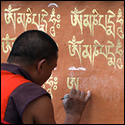|
By all means feel free to follow along and participate!
|
|
|
|

|
| # ? Apr 26, 2024 11:50 |
|
If anyones interested, it's Buddha's birthday this Friday here in Korea (and probably other countries, too.) So, make of it what you will, and happy Buddha's Birthday everyone! Edit: and it was a good one  Hope it was nice for everyone else. Can anyone comment on the purpose and significance of bowing and prostrating to statues? BrainDance fucked around with this message at 19:28 on May 17, 2013 |
|
|
|
It's to show reverence for the teachers who laid the path- and also a sign of humility. I'll be celebrating Shakyamuni's birth on Vesak, which is friday! So hopefully it will be good for me! (it won't, I'm not in a largely buddhist area)
|
|
|
|
Quantumfate posted:It's to show reverence for the teachers who laid the path- and also a sign of humility. Also to expand, from a Vajrayana perspective: Buddha has no physical form but is believed to exist (and not exist, and both, and neither, etc.) in the form of emptiness. Because Buddha has attained emptiness, essentially any Buddha-image and Buddha-form is the Buddha, because it's not not the Buddha. This is why Buddha images are not used for decoration in Tibet, and it is for example very rude to extend the soles of the feet towards a Buddha statue, and so on. And in the preliminary practices of many lineages, high numbers of prostrations are used to both teach humility and also to accumulate merit (prostrating anything is an act of humility, taking Refuge is often accompanied by prostrations, and both activities generate merit, so in that wonderfully low-magic sort of way, banging out 100k prostrations accumulates lots of merit, which can serve to assist in attaining Buddhahood).
|
|
|
|
What does Korean Buddhism fall under? My first time in a Korean Buddhist temple a lay practitioner described the prostrating to me as something to bring good favor. Her English was limited though, so I couldn't get more than a basic answer. I took part in it last weekend but feel a little like maybe I shouldn't have, without understanding it more.
|
|
|
|
BrainDance posted:What does Korean Buddhism fall under? My first time in a Korean Buddhist temple a lay practitioner described the prostrating to me as something to bring good favor. Her English was limited though, so I couldn't get more than a basic answer. Merit and good favor could be more or less the same given poor English command. I believe Korean Buddhism tends to be Zen or Vajrayana, but I am not able to look it up right now. There is if I recall a pretty robust Wikipedia entry about Korean Buddhism though that I remember reading once. I don't see any problem in taking part in prostration even without understanding all the reasons. Generally meritorious actions are meritorious whether you intend them or not. For example animals can gain merit by walking around stupas or prostrating even though they do so without intent.
|
|
|
|
After chatting with paramemetic, I have a question I'd like input on- Or rather an interesting sort of dilemma. I've been meditating outside a fair bit, and while doing this I observed an ant moving to what was clear to me: a spider web. As I had been making a habit of helping out animals I meet, I naturally pushed the little girl onto another direction with a gentle prod from a twig. Upon reflection though this action denied the spider a meal and may have meant starvation or suffering. Now obviously billions of beings die each day, suffering will continue to exist, and to dwell on all those suffering can be a hinderance because we cannot help them all. But the dilemma is that in this instance you are perfectly poised to help a sentient being- Should you intervene on behalf of the ant? On behalf of the spider? Should you remain inactive and simply say Manis and Mantras to help the ant attain a different birth and to help the spider who causes suffering with a necessary act?
|
|
|
Quantumfate posted:After chatting with paramemetic, I have a question I'd like input on- Or rather an interesting sort of dilemma. I've been meditating outside a fair bit, and while doing this I observed an ant moving to what was clear to me: a spider web. As I had been making a habit of helping out animals I meet, I naturally pushed the little girl onto another direction with a gentle prod from a twig. Upon reflection though this action denied the spider a meal and may have meant starvation or suffering. You did deny the spider a meal, but you also saved the spider from the karma of killing. Wanton killing is kind of one of the bad points of being born as an animal. It's silly to try to prevent the spider from ever eating, thus killing him. It's also silly to ignore the opportunity to save a life that is right in front of you simply because ~the circle of life~
|
|
|
|
|
Did anyone have a difficult time reading Zen Mind, Beginner's Mind? I'm about 50% through and it's a little bit of a strange read. I've found Thich Nhat Hanh's translations to be much easier to understand, but I'm trying to expand beyond reading Thay's work.
|
|
|
Shnooks posted:Did anyone have a difficult time reading Zen Mind, Beginner's Mind? I'm about 50% through and it's a little bit of a strange read. I've found Thich Nhat Hanh's translations to be much easier to understand, but I'm trying to expand beyond reading Thay's work. I'm doing alright with it, but it is very strange indeed.
|
|
|
|
|
If i only had to read one book about zen, i think it would be "Zen mind, beginner's mind" ! Everything is in it. You got really simple and down to earth practice advice, but also more philosophical points of view, a lot of humor, and a very poetic and strange style. If by "difficult" you mean that sometimes you don't understand, it's totally normal and it is also what makes this book so valuable : first because it teaches you that you don't need to understand everything and that it's ok, which is something really important in zen, you don't have to "know", things don't have to "make sense", there are paradoxes everywhere ; but more importantly, you can read it multiple times, following your progress in practice, and always discover new things about practice that were in the book from the beginning but that you did not understand before. It is a book i read at least 4 times in the last year, and every time my understanding of it evolves. It truly is one great book. If you want something that makes sense and is a lot more easy to understand, you can try Nishijima's "Facing the real dragon", which gives biological and philosophical explanations of zen but also really strong practice advice. Then maybe one day try to read Nishijima's translation of Dogen's "Shobogenzo", it's wonderful, but it can take a lifetime to study it properly.
|
|
|
|
Quantumfate posted:But the dilemma is that in this instance you are perfectly poised to help a sentient being- Should you intervene on behalf of the ant? On behalf of the spider? Should you remain inactive and simply say Manis and Mantras to help the ant attain a different birth and to help the spider who causes suffering with a necessary act? I was in a somewhat analogous situation a few years ago. I worked at an arboretum which, due to the large expanses of 'natural' habitat within a city, was home to 'wild' animals. In June of that year, we started seeing a fox with mange who we watched die over several weeks. The arboretum's policy was "let nature take its course". I asked the director and was given the option to catch it, take it to the vet, and pursue treatment, but it was all on me. Consulting with my spiritual friend, his advice was that by interfering with the foxes life, I would be intervening in another sentient beings karma. He asked if I willing to do that and accept the results? Did I understand the causes and conditions that led to this situation well enough to say "This situation is wrong and I must do something"? Was my desire to step in out of true compassion or idiot compassion? HTH
|
|
|
|
Any goons in the Chicago Western suburbs? I've been meaning to check this place out and was wondering if anyone had any experience there. I've been practicing alone for years and would love to have a group to meet with. http://www.ibpschicago.org/default_en.htm
|
|
|
|
|
I wanted to gain clarification on one aspect of Buddhism: Love. Love seems to be one of the most important concepts to the Buddha, from my very little research and understanding on the topic, but the Preta, or "Hungry Ghosts", are supposedly attached to the world for a variety of reasons, one of them being Love. How does this work? Is it particular kinds of love(i.e. Platonic vs. Romantic vs. Friendship), or ways of loving, or is it an intensity thing? I always thought about it like this: the Buddha wants us to love and bring happiness to others always, but accept their deaths as an inevitability, allowing us to be both deattached and attached. But again, I'm not a Buddhist. Thanks in advance!
|
|
|
|
Hiro Protagonist posted:I wanted to gain clarification on one aspect of Buddhism: Love. Love seems to be one of the most important concepts to the Buddha, from my very little research and understanding on the topic, but the Preta, or "Hungry Ghosts", are supposedly attached to the world for a variety of reasons, one of them being Love. How does this work? Is it particular kinds of love(i.e. Platonic vs. Romantic vs. Friendship), or ways of loving, or is it an intensity thing? I always thought about it like this: the Buddha wants us to love and bring happiness to others always, but accept their deaths as an inevitability, allowing us to be both deattached and attached. But again, I'm not a Buddhist. Thanks in advance! As far as I understand things, love isn't the term I often see to describe what is more generally emphasized as compassion, which in our language love would be a little over general as far as terms go. It would be in line with the agape or caritas conception of selfless love for others, but in many ways is at odds with some of the other conceptions, particularly Eros. For monastics of just about all settings the vinaya is pretty explicit in saying monks aren't supposed to be having sex (which doesn't mean it didn't happen of course), as its one of those things which so easily breeds, pun not intended, attachments. And this is so throughout most of the tradition, even Mahayana leaning monks lived in the same monasteries and followed the same vinayas as mainstream Buddhists (there is no such thing as a Mahayana vinaya), with vinaya being the big thing that identified your sect. For lay practitioners, the ideal is more realistic an captured in the pancha sila as an injunction against sexual misconduct and immorality, as generally interpreted and determined my surrounding social mores. As far as it being an intensity thing, I don't really think so, rather its more an attachment thing and a motive thing. So often love happens to be about sexual gratification, the good feelings it brings one's self, what the other person can/is doing for me, etc. and in that sense love can be problematic. In other ways it can be a sort of intoxicating substance, leading to all sorts of unhealthy attachments on other things. I've met many people who feel that if they're not in love or a relationship, they're failing a societal standard, they're not attractive or worthy, and it causes all sorts of distress. That's clearly attachment to a variety of things aside from and in addition to love. It's almost a truism to state that love can lead to both selfish and selfless behaviors, and in the sense that it is a mask for selfish motives and behaviors, for self-gratification, this is what damns the pretas in my mind. But in the ways love leads to selflessness, particularly when that love is not restricted to just one entity (which is in turn then is so often about how that entity makes ME feel, what they do for ME etc.), then it's the sort of thing that only leads to compassion and would be an unequivocal good. Yiggy fucked around with this message at 10:43 on Jun 3, 2013 |
|
|
|
Possessive love would be viewed differently than simply loving something for what it is.
|
|
|
|
Hiro Protagonist posted:I wanted to gain clarification on one aspect of Buddhism: Love. Love seems to be one of the most important concepts to the Buddha, from my very little research and understanding on the topic, but the Preta, or "Hungry Ghosts", are supposedly attached to the world for a variety of reasons, one of them being Love. How does this work? Is it particular kinds of love(i.e. Platonic vs. Romantic vs. Friendship), or ways of loving, or is it an intensity thing? I always thought about it like this: the Buddha wants us to love and bring happiness to others always, but accept their deaths as an inevitability, allowing us to be both deattached and attached. But again, I'm not a Buddhist. Thanks in advance! Not able to answer for Buddhism as a whole, really, and the above answers apply very well, but today while talking about Lord Jigten Sumgon as today is his anniversary, my lama discussed that Jigten Sumgon has taught that for beginning practitioners and such it is often more beneficial to meditate on love than on compassion, because meditating too much to develop compassion can lead to agitation and suffering if it is not developed in the context of bodhicitta. The difference is that of meditating on love for all sentient beings as your mother just naturally, respecting every sentient being as the one who has been kind for you in this and past lives, and loving all sentient beings with equanimity and kindness, treating every being as your guest, mother, guru, and Buddha. The equivalent to love in this sense would be close to the Greek concept of Agape, or perhaps the Latin virtue of Caritas, or just generally compassionate or altruistic love. Compassion is the feeling of movement that inspires us to act to benefit suffering sentient beings. We want to ease that suffering, we feel their suffering as our own and we are moved toward action to benefit them. Combined, love (loving-kindness is often how it's rendered in Buddhist literature) and compassion join to form Bodhicitta, the foundation of the Mahayana philosophy, that of a strong desire to attain perfect Buddhahood for the benefit of all sentient beings, in order to ease the suffering of others, rather than the desire to pass into parinirvana purely for the cessation of one's own suffering. But without love, meditating on compassion can drive us crazy, as developing it can lead to psychic trauma, thinking about all the immense suffering in the entire world. Developing both, however, provides a strong motivation to benefit sentient beings.
|
|
|
|
How do you meditate on something?
|
|
|
|
The-Mole posted:How do you meditate on something? Direct your thoughts towards it. With love, it's suggested to focus on your mother (by Tibetans, who are very into mothers, but anybody you love will work). You just focus your attention there and consider how they have treated you well, how they reduce your suffering, nurture you, etc. For compassion, you can focus on the same thing, but that person's suffering, and how you have felt similar suffering, and so on. Not all meditation is calm-abiding, and metta (lovingkindness and compassion) can be or it can be something else. Although it can be a form of calm-abiding, if you focus on such concept as your referent object. Also there is a general conception of meditation involving freeing the mind of thoughts or not thinking, but this is not always the case. In Drikung Kagyu practice my understanding is that thoughts should be redirected towards the referent if that's what you're doing, especially in the early stages of learning meditation, but that thoughts are simply dependently arising phenomenon like anything else, and so at some point one simply abides them coming and going as well, so long as it can be done without grasping. After all, being rid of thought entirely is still grasping. Paramemetic fucked around with this message at 02:04 on Jun 4, 2013 |
|
|
|
I guess I'm wondering more how someone would meditate 'on' something other than compassion.
|
|
|
|
Regarding meditating on things, and how practice isn't always just keeping the mind calm and clear, I would like to offer a reading to the thread. It's from the zen perpective, but I feel like it has applications for all sorts of practice. It's the concluding chapter wrapping up the book, but I feel like it stands well enough on its own. Meditations on Zen Buddhism by David Wright posted:
|
|
|
|
Posting to say thanks for the thread. I lived in Thailand for a year and the section on Theravada helped me better understand the role that Buddhism has in their culture.
|
|
|
|
The Mindfulness in Plain English ebook was amazing. Thanks for posting it in this thread! Does anyone here practice Vipassana meditation? Sonata Mused fucked around with this message at 00:57 on Jun 6, 2013 |
|
|
|
Sonata Mused posted:The Mindfulness in Plain English ebook was amazing. Thanks for posting it in this thread! I love that book and practice vipassana/mindfulness meditation. I'm interested in learning more about transcendental meditation and am curious to hear anyone's thoughts on that. Also, is it necessary to do the ~$300 training for it? It almost seems scammy that so many celebrities endorse it but it also has the most peer-reviewed research.
|
|
|
|
khysanth posted:I love that book and practice vipassana/mindfulness meditation. Hi. I grew up in the TM movement. I can answer any questions you may have through PM. It's not necessary to spend large amounts of money to learn meditation. Many places will teach you for free. In Buddhism one is usually taught for free.
|
|
|
|
I know it doesn't really matter, but has anyone used Mala for things other than chanting? Some of the meditation and mindfulness practices I do require counting and I was thinking carrying a small mala around would be easier than keeping it in my head.
|
|
|
|
Shnooks posted:I know it doesn't really matter, but has anyone used Mala for things other than chanting? Some of the meditation and mindfulness practices I do require counting and I was thinking carrying a small mala around would be easier than keeping it in my head. I keep a mala with me pretty much all the time. I know opinions differ but I think of it as a tool. When the mood strikes or I have a spare moment I'll recite mantras and use it to count, or if I want to pray I use it for gassho. I'm pretty spontaneous about these things so having something always on hand makes sense to me.
|
|
|
|
How has the counting been significant, out of curiosity?
|
|
|
|
The-Mole posted:How has the counting been significant, out of curiosity? huh?
|
|
|
|
Shnooks posted:I know it doesn't really matter, but has anyone used Mala for things other than chanting? Some of the meditation and mindfulness practices I do require counting and I was thinking carrying a small mala around would be easier than keeping it in my head. In Tibet where some practices involve hundreds of thousands of prostrations there are additional counters that attach right to the mala to let you keep track of way many more numbers. So yeah. The mala is a tool. It's a religious tool, and often blessed, but it is a tool regardless, so feel free to use it as such. Also in Tibet they are sometimes used for divination and decision making so there's that. It's really a very utilitarian device. I guess as long as you're not using it to count murders or something it's fine. The only exception I can think of is mala consecrated for use in deity yoga, which need treated with respect throughout the practice at least.
|
|
|
|
Paramemetic posted:In Tibet where some practices involve hundreds of thousands of prostrations there are additional counters that attach right to the mala to let you keep track of way many more numbers. So yeah. The mala is a tool. It's a religious tool, and often blessed, but it is a tool regardless, so feel free to use it as such. I've been told that a practitioner should be aware of what the mala is made of: certain materials shouldn't be used for certain practices. For example, a bone mala shouldn't be used in particular Sadhanas. I'm going to Tibet next month and visiting the former seats of the Kagyu and Sakya lineages as well as other cities and sites. Is there anything I should be aware of with regard to etiquette specific to monastery visits or Tibet in general?
|
|
|
Leon Sumbitches posted:I'm going to Tibet next month and visiting the former seats of the Kagyu and Sakya lineages as well as other cities and sites. Is there anything I should be aware of with regard to etiquette specific to monastery visits or Tibet in general? If you're traveling by any method other than road, go find a doctor before you leave and get Diamox seriously get Diamox THIS WILL NOT END WELL FOR YOU IF YOU DO NOT HAVE DIAMOX. Take it from someone who had to carry his AMS-ridden wife onto a plane and deal with mud brick hospitals, unsterilized oxygen tank nosepieces, and holy-poo poo-why-are-there-lizards-in-the-bathroom. Seriously. That was WITH Diamox too. Take it easy for at least two days after you arrive, and not "only do some light sightseeing" like "recuse yourself with a book and only get up to poop and maybe to piss." Seriously, the human body was not made to go to those altitudes at those speeds.
|
|
|
|
|
Try to avoid riding a horse into their monasteries. It is not completely forbidden, but generally it is frowned upon.
|
|
|
|
WAFFLEHOUND posted:If you're traveling by any method other than road, go find a doctor before you leave and get Diamox seriously get Diamox THIS WILL NOT END WELL FOR YOU IF YOU DO NOT HAVE DIAMOX. Take it from someone who had to carry his AMS-ridden wife onto a plane and deal with mud brick hospitals, unsterilized oxygen tank nosepieces, and holy-poo poo-why-are-there-lizards-in-the-bathroom. Seriously. That was WITH Diamox too. Take it easy for at least two days after you arrive, and not "only do some light sightseeing" like "recuse yourself with a book and only get up to poop and maybe to piss." As the person who had to be carried onto a plane due to severe-AMS, TAKE DIAMOX! I was fine at 12,500 ft for 2 and a half weeks WITH diamox until we set out trekking. AMS is not a pleasant experience - be sure to take it easy for a while.
|
|
|
|
Sonata Mused posted:The Mindfulness in Plain English ebook was amazing. Thanks for posting it in this thread! Yep. I went on a 10-day Vipassana retreat a while back, and plan on doing another one soon. Highly recommended. Don't forget about this book: http://www.interactivebuddha.com/mctb.shtml
|
|
|
qwerasdf posted:Yep. I went on a 10-day Vipassana retreat a while back, and plan on doing another one soon. Highly recommended. I've really wanted to do this for a while, mind sharing any more?
|
|
|
|
|
WAFFLEHOUND posted:I've really wanted to do this for a while, mind sharing any more? The course I went to was instructed by Goenka (not in person, but via audio/video). You can sign up for these courses at dhamma.org (although you'll have to do it weeks/months in advance, especially if you're a girl, because they seem to be in demand.) The courses are 10 days long, non-denominational, and most importantly, free. If you make it to the end, they do accept donations, which will go toward the next course, and toward building more facilities. During this time, you aren't allowed to communicate to anybody else but your instructor. Yes, that means giving up your cell phones and gadgets for 10 days to a storage locker. I suppose you could get away with something though; it's not like they're going to frisk you  . .The majority of the people there were probably college-aged kids, with some older Indians filling the remainder. Men/Women are separated to prevent distraction, and the only time that you see the opposite sex is in the meditation hall, although you're not really supposed to look at them (I probably did.) Basically, you meditate for ~10 hours a day either in the hall or in your room when given the option. You're day goes from 4:30a to 9:30p, although most will sleep-in during the first two hours, because it's 4:30 in the goddamned morning when the gong sounds. Don't cheat yourself here if you can help it. The sessions are 1 to 1 1/2 hours long, with breaks in between. You'll know when a session is wrapping up because they play a CD of Goenka chanting something for a couple minutes. Seems weird at first, but you get used to it. Eventually he tells you what the hell he's saying. At the end of each day, they play an (old) video of Goenka himself talking about what you are experiencing. This guy is actually pretty entertaining, and you'll look forward to listening to his stories every night. I should point out that there's really very little talk of beliefs and such things as reincarnation; this course is all about a mental exercise with perhaps a dash of philosophy. There are two instructors there who don't really do much except ask you how you are doing periodically. They also have what I call "office hours" after lunch where you can go talk to them. This is where I go to complain about my rear end hurting after 5 days of sitting; but they are extremely helpful and will answer all of your questions. That leads me to another point: You are going to f'ing hurt after a few days of sitting. They do have some chairs, meditation benches, and some extra cushions, and boy are people piling that poo poo up by the end of 10 days. You can also lean against the back wall, assuming someone else hasn't already built a cushion fort back there. I recommend you bring a bunch of cushions and whatnot, because you'll need it unless you've been doing this for years. I can't sit cross-legged and keep my back straight, so I stacked cushions under me and put my knees forward. People were thanking me at the end for showing them that position  . .On the last day, you're allowed to communicate again in order to get re-acclimated to normal life. This is always a fun time because you get to talk to people about things you've experienced over the past 10 days, including things like "Why did that girl freak out on day 3?" and "What's up with that one dude that kept farting out loud?" Anyway, my meditative experience went as follows: For the first 3 days, you practice concentration meditation, and for the other 7, Vipassana. Day 1-2: By the end of day 2, I was able to focus on my breath/nose without my mind wandering more than once for the whole hour. Pretty incredible, considering that I couldn't manage it for 5 seconds when I first started. Day 3: My face kind of feels like it's melting off to the side. Also, feeling tingling sensations on my face (what they call 'vibrations'). Day 4-5: Scanning my whole body now, feeling some vibes here and there, drat my knees are starting to hurt. Day 5-7: I can feel vibrations over most of my body, even though there are a few "blind" spots. I can't believe this is real. Day 8-10: drat the physical pain, getting pretty angry, why doesn't Goenka shut the hell up that stupid jerk. Overall, very interesting, and I would say *crucial* to anyone who wants to try meditating. Trust me, most of you'll probably get bored of trying to meditate on your own for 30-60 minutes every day if you're a beginner. It really helps to take one of these courses to jump-start your practice. Because I didn't manage the physical pain very well, I didn't progress as far as I could have; however in the weeks following, I started to witness incredible things. I once found myself meditating within a dream, and felt like I was going to explode, which is both terrifying and awesome. I can honestly say that I've stumbled upon something profound and life-changing, and I'm only scratching the surface. Sorry for my terrible writing. qwerasdf fucked around with this message at 07:18 on Jun 18, 2013 |
|
|
|
I'd really like to try one of these retreats but with a wife who doesn't meditate using all my vacation days for a year for it seems pretty unreasonable. 
|
|
|
|
khysanth posted:I'd really like to try one of these retreats but with a wife who doesn't meditate using all my vacation days for a year for it seems pretty unreasonable. There are plenty of opportunities for shorter retreats, albeit not in that particular style. For example, the Shambhala Center of Seattle offers a summer retreat in the city that people are allowed to attend only part of if that's all they're able. It's not an all or nothing thing, and any kind of deepening experience is well worth it. Even a two day weekend program is helpful.
|
|
|
|

|
| # ? Apr 26, 2024 11:50 |
|
khysanth posted:I'd really like to try one of these retreats but with a wife who doesn't meditate using all my vacation days for a year for it seems pretty unreasonable. Further to Leon's post, some additional examples from zen centers: http://www.sfzc.org/cc/display.asp?catid=2,6,120 http://www.rzc.org/sesshins-meditation-retreats/upcoming-sesshins/ Look around and you may well find something that works for you.
|
|
|






























